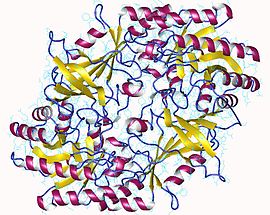Ornithine decarboxylase
| ornithine decarboxylase | |||||||||
|---|---|---|---|---|---|---|---|---|---|

Ornithine decarboxylase dimer, Human
|
|||||||||
| Identifiers | |||||||||
| EC number | 4.1.1.17 | ||||||||
| CAS number | 9024-60-6 | ||||||||
| Databases | |||||||||
| IntEnz | IntEnz view | ||||||||
| BRENDA | BRENDA entry | ||||||||
| ExPASy | NiceZyme view | ||||||||
| KEGG | KEGG entry | ||||||||
| MetaCyc | metabolic pathway | ||||||||
| PRIAM | profile | ||||||||
| PDB structures | RCSB PDB PDBe PDBsum | ||||||||
| Gene Ontology | AmiGO / EGO | ||||||||
|
|||||||||
| Search | |
|---|---|
| PMC | articles |
| PubMed | articles |
| NCBI | proteins |
| ornithine decarboxylase | |
|---|---|
| Identifiers | |
| Symbol | ODC1 |
| Entrez | 4953 |
| HUGO | 8109 |
| OMIM | 165640 |
| RefSeq | NM_002539 |
| UniProt | P11926 |
| Other data | |
| EC number | 4.1.1.17 |
| Locus | Chr. 2 p25 |
The enzyme ornithine decarboxylase (ODC) catalyzes the decarboxylation of ornithine (a product of the urea cycle) to form putrescine. This reaction is the committed step in polyamine synthesis. In humans, this protein has 461 amino acids and forms a homodimer.
Lysine 69 on ornithine decarboxylase (ODC) binds the cofactor pyridoxal phosphate to form a Schiff base. Ornithine displaces the lysine to form a Schiff base attached to ODC, which decarboxylates to form a quinoid intermediate. This intermediate rearranges to form a Schiff base attached to putrescine, which is attacked by lysine to release putrescine product and reform PLP-bound ODC.
This is the first step and the rate-limiting step in humans for the production of polyamines, compounds required for cell division.
The active form of ornithine decarboyxlase is a homodimer. Each monomer contains a barrel domain, consisting of an alpha-beta barrel, and a sheet domain, composed of two beta-sheets. The domains are connected by loops. The monomers connect to each other via interactions between the barrel of one monomer and the sheet of the other. Binding between monomers is relatively weak, and ODC interconverts rapidly between monomeric and dimeric forms in the cell.
...
Wikipedia

